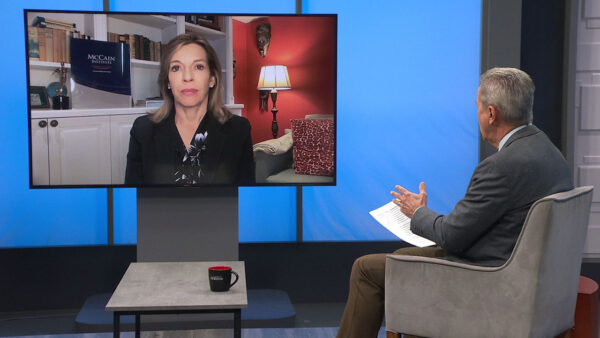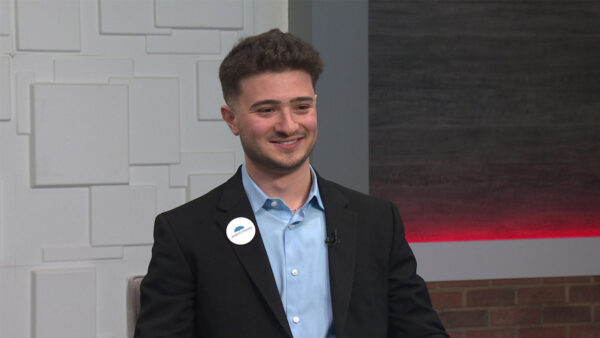Patrick McWhortor, President and CEO of Alliance of Arizona Nonprofits, shares the findings of a statewide survey of Arizona nonprofits contained in the new report Borderline: Hope and Concern for Arizona Nonprofits.
Ted Simons: Coming up next on "Arizona Horizon," hope and concern for Arizona's 21,000 nonprofits as they meet the challenges of the economic recession. And how one valley nonprofit is trying unlock the mysteries of Alzheimer's disease. Next on "Arizona Horizon." Good evening, and welcome to "Arizona Horizon," I'm Ted Simons. A federal appeals court will not stop forced medication of Tucson shooting suspect Jared Loughner. Last year a federal judge declared Loughner mentally unfit to stand trial after experts said he likely suffers from schizophrenia. Officials are treating him with 2 psychotropic drugs to try to make him ready for trial. Today a three-judge panel from the 9th Circuit Court of Appeals ruled 2-1 the forced medication may continue, despite objections from Loughner's attorneys. According to the Alliance of Arizona Nonprofits, the state is home to about 21,000 nonprofit organizations that employ more than 150,000 people. These groups provide critical services, improve quality of life, some even save lives with cutting edge medical research. The economic recession has made it difficult for all types of nonprofits to do their jobs. A new statewide record entitled "Borderline: Hope and Concern for Arizona Nonprofits," took a look at the state of nonprofits in Arizona. Here with more on the study is Patrick McWhortor, president and CEO of the Alliance of Arizona Nonprofits. It's good to see you here, thanks for joining us.
Patrick McWhortor: Glad to be here, Ted.
Ted Simons: What, 21,000 nonprofits, 150,000 folks employed, and I'm guessing hundreds of thousands of volunteers?
Patrick McWhortor: Absolutely. More than half of Arizonans are involved in nonprofits and volunteering. So these are organizations that are a part of all of our lives.
Ted Simons: Indeed. And this survey, 170 some odd nonprofits surveyed here, who got the questionnaire?
Patrick McWhortor: We sent it to nonprofits all over the state. We're a membership organization with about 600 members which is pretty reflective and representative of the whole sector. We always make sure that we reach out to get all parts of the sector involved in the survey so we believe that the the results are reflective of the nonprofits as a whole statewide.
Ted Simons: I understand churches were kind of underrepresented. What was that about?
Patrick McWhortor: Well we don't have a lot of churches in our membership they tend to have their own networks and organizations. So we have some churches, but they are about 10% of the sector and a very small part of our survey.
Ted Simons: So what was asked in the survey? And what did you find regarding the impact of the recession on nonprofits?
Patrick McWhortor: Well, we have been surveying nonprofits for about four years now on the impact of the recession on revenues, the services provided by organizations and ultimately on the operations and staffing of these organizations. We have followed the trends over four years. In 2011, the trends pretty much continued that the demand for services is up and yet revenues are down. Organizations are doing more with less each year. The good news is some of those trends moderated in 2011. Revenues were down for nearly half the organizations, but not as much as we've seen in the past three years.
Ted Simons: Let's talk about some of the revenues here. As far as fewer than half of nonprofits reporting revenue loss as you mentioned, about half of donations expect to increase. That's somewhat optimistic.
Patrick McWhortor: The good news is individuals continue to donate to nonprofits, many times the volunteers we talked about a moment ago. Remember, that is the smallest source of income from the community at large. The largest source of income for nonprofits is earned income, fees for services. They go to the museum and pay an entrance fee, that's called earned income. The second largest source for nonprofits as whole is government contracts and grants, those have been really battered during the recession and continue to look pretty grim in the future. Really, donations are strong, but that's the smallest of the three major sources of income for nonprofits.
Ted Simons: Major funding is still a concern. Sounds as like 31%, a third of the folks you talk to expect those government sources to continue to decline.
Patrick McWhortor: Absolutely. For some sectors that's particularly severe. Human services organizations get about 60% of their income government contracts and grants. State and local funding has been dropping for the past two years. At the federal level they sometimes fill that gap but now we're seeing the federal budget put a strain on those resources. The outlook for government resources is still quite grim.
Ted Simons: As far as which sectors are hit harder than others, looks like arts and culture are hit especially hard.
Patrick McWhortor: Arts and culture were a surprise this year. They expected to see some improvement. The economy is starting to show signs of improvement. They are especially dependent on disposable income. Again, I mentioned the museum or the symphony. A lot of arts programs are dependent upon individual donations. When people are making those contributions, that's when they have disposable income. So they thought well the economy's coming back things should be better. In fact, especially for earned income, they saw declines as high as 25% in 2011. They were surprised by that.
Ted Simons: Surprised by that. Any idea as to why?
Patrick McWhortor: People are still pretty conservative with their dollars in these tight times, families are still struggling. Even wealthier individuals maybe are not -- they are putting their money away into savings instead of using it to partake of the arts. We are concerned that that trend -- we don't want to see that continue, because arts organizations are especially dependent upon that earned income and those donations.
Ted Simons: It sounds as though strains on the nonprofit workforce seem to be easing a bit. Is that what you got from the study, as well?
Patrick McWhortor: The fact is the way nonprofits have done more with less for the last four years has put a lot of stress on their staff. They have cut positions or hours, they have certainly frozen or cut pay and benefits. People leave positions vacant, if somebody leaves they are doing two and three jobs. We are seeing a little less of that. We asked if organizations are cutting positions during the recession. They say they are replacing the positions but demand continues to rise.
Ted Simons: What about suffering because of the lack of stable employment and restoring some of those jobs that were lost.
Patrick McWhortor: The good news that is nonprofits have not laid off people to the extent in the for-profit sector, we've seen that trend nationally, as well. Some of our for-profits had lean staff to begin with, we didn't have anybody to lay off. We are hopeful to be able to see those positions start to come back to meet this continuing growing demand.
Ted Simons: And you've talked about demand a couple of times here. The demand just keeps on growing, doesn't it?
Patrick McWhortor: Remember, nonprofits are on the front lines of dealing with this recession. Many, many families in Arizona are still suffering the effects of the recession. You have organizations helping with foreclosure assistance, financial literacy, obviously homeless shelters, victims of domestic violence, and on and on. These issues are getting worse, not better. Yet these organizations are out there trying to meet the needs with fewer resources.
Ted Simons: I was going to say, it's very different from the private sector isn't it. The nonprofits look at a recession and all of a sudden demand increases. Private sector, just the opposite.
Patrick McWhortor: Exactly. There is a link between the private sector and the nonprofit sector. We also are partners with them, we need their support. Their employees expect there is going to be human reserves for them. They have to have the resources, we really struggle when we don't have the resources to be able to continue providing services.
Ted Simons: And yet 90% of nonprofits expect to meet demand this year.
Patrick McWhortor: Yes that's the amazing thing, it is an incredibly resilient sector. Sometimes maybe to our own peril people say, gee, you keep doing this year after year, I guess you don't need more donations. That's not really true. The staff are especially strained. We have a small joke, which is: If jobs start to picking up in the private sector again, that'll be bad news because the staff will flock to the better jobs. So maybe it's good the economy isn't picking up. Of course that's not really true, we want to see the economy improve.
Ted Simons: The underlying aspect of the whole report is fiscal stability in one way shape or form. Lots of deficits out there, lots of folks tapping into reserves, what's the overall picture there?
Patrick McWhortor: We are very concerned that organizations have been tapping what are already fairly meager reserves. Over half of organizations have fewer than four months of operating resources on hand. That is how they're covering these deficits, how they are able to do more with less. That is not sustainable. We're seeing some indication that organizations are going to merge and consolidate, or find other ways of working in partnership with other nonprofits, other entities in the community. That's probably the trend for the future. We've been a little surprised we haven't seen more examples of that. We have examples of mergers but not as many as we might have expected. But it's very complex and time consuming to do these mergers. We think we may see more in the future.
Ted Simons: The survey says half are committing resources to advocacy. What does that mean and is there kind of a balancing act that needs to be done when you talk about nonprofits and advocating things?
Patrick McWhortor: Advocacy is broadly reaching out into the community, talking about your story and your mission, how you make a difference in the community. It also includes public policy advocacy, going to the legislature or the City Council or federal government and trying to get help on your issues there. There are some rules that nonprofits have to follow with the IRS around that. There's a lot of room to see otherwise to do a lot of advocacy as a nonprofit.
Ted Simons: Sounds like raising the profile of nonprofits is the major goal.
Patrick McWhortor: That is the most critical issue going forward. 70-some% of organizations are increasing marketing outreach efforts, trying to get more people in the community who understand how they are meeting these vital community needs. They need the community's support in order to continue that.
Ted Simons: Last question: Cautious optimism in this report?
Patrick McWhortor: Very cautious. We're still concerned about other shoes yet to drop. We mentioned arts and culture, we're very concerned about the health sector going forward the AHCCCHS cuts at the state level, they could lead to the most significant layoffs we have yet to see in the recession. These are still very dangerous times for nonprofits in Arizona.
Ted Simons: Good to have you here, thanks for the information, we appreciate it.
Patrick McWhortor: Glad to be here, thank you.
Patrick McWhortor:President and CEO of Alliance of Arizona Nonprofits;























